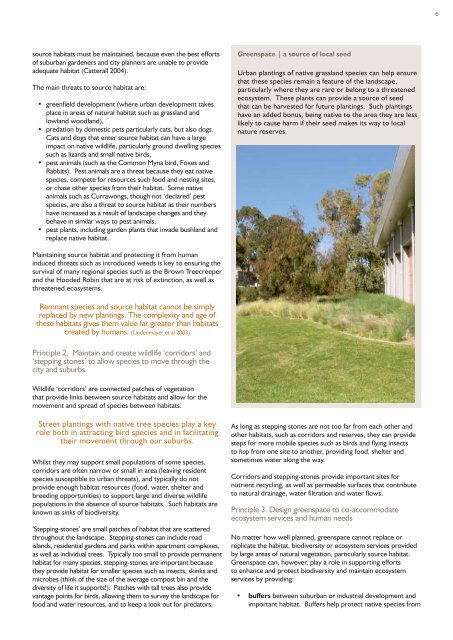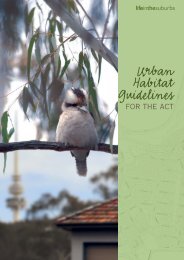5Part 2. Manag<strong>in</strong>g urban biodiversityObjectiveThe growth of agriculture and forestry <strong>in</strong> rural areas surround<strong>in</strong>g<strong>the</strong> ACT, and <strong>the</strong> growth of <strong>the</strong> city of Canberra and its suburbshave seen large areas of natural habitat replaced with humanmodified landscapes. As a result, much of <strong>the</strong> habitat that oncecharacterised <strong>the</strong> region has been lost, dim<strong>in</strong>ished <strong>in</strong> quality orreduced <strong>in</strong> area, and rema<strong>in</strong><strong>in</strong>g patches have become isolated fromeach o<strong>the</strong>r. These changes <strong>in</strong> <strong>the</strong> landscape have placed significantpressure on natural ecosystems and <strong>the</strong> biodiversity that supports<strong>the</strong>m. In some cases changes are of a scale that threatens <strong>the</strong>existence of entire ecosystems and <strong>the</strong> services <strong>the</strong>y provide.In <strong>the</strong> ACT, two natural ecosystems are threatened: lowlandwoodland and lowland native grassland. If <strong>the</strong>se ecosystems, <strong>the</strong>irspecies, and <strong>the</strong> roles <strong>the</strong>y play <strong>in</strong> ma<strong>in</strong>ta<strong>in</strong><strong>in</strong>g healthy landscapesare to be ma<strong>in</strong>ta<strong>in</strong>ed, <strong>the</strong> pressures that urban development andhuman settlement impose on <strong>the</strong>m must to be addressed.<strong>Urban</strong> biodiversity management aims tocomplement <strong>the</strong> role of non-urban landscapes <strong>in</strong>provid<strong>in</strong>g wildlife habitat and ecosystem services, whilemeet<strong>in</strong>g <strong>the</strong> needs of <strong>the</strong> human population.Pr<strong>in</strong>ciplesThe follow<strong>in</strong>g pr<strong>in</strong>ciples provide a guide to manag<strong>in</strong>g andenhanc<strong>in</strong>g urban biodiversity us<strong>in</strong>g basic conservation concepts.The pr<strong>in</strong>ciples target different types of greenspace, from naturereserves to backyard gardens, and highlight <strong>the</strong> role that humanbehaviour can play <strong>in</strong> protect<strong>in</strong>g urban ecosystems by manag<strong>in</strong>gthreats to biodiversity, wildlife and habitat.The Brown Treecreeper | <strong>in</strong> need of spaceThe Brown Treecreeper (Climacteris picumnus) was a commonfeature of <strong>the</strong> lowland woodland and open forest ecosystemsthat were once common at lower elevations with<strong>in</strong> <strong>the</strong> ACT.In <strong>the</strong> last 10 years, however, it has all but disappearedfrom habitats less than 300 hectares <strong>in</strong> area, and has beendeclared vulnerable to ext<strong>in</strong>ction <strong>in</strong> <strong>the</strong> ACT.Why habitats larger than 300 hectares?Females leave <strong>the</strong> territory where <strong>the</strong>y were born, whe<strong>the</strong>ror not suitable habitat is available. As a result of human<strong>in</strong>duced pressures such as predation by cats and foxes andhabitat replacement, <strong>the</strong> areas where it is able to survive arenow limited.Small populations of <strong>the</strong> Brown Treecreeper are restrictedto habitat along <strong>the</strong> Lower Naas River, Goorooyarroo,<strong>the</strong> Clear Range, Burbong, Majura Field Fir<strong>in</strong>g Range andNewl<strong>in</strong>e Quarry.Helen Fallow © 2006Pr<strong>in</strong>ciple 1. Ma<strong>in</strong>ta<strong>in</strong> large areas of natural vegetation toprovide stable habitat for a large variety of local speciesLarge areas of natural to semi-natural wildlife habitat, such asnature reserves, national parks and private reserves providesources of biodiversity. Be<strong>in</strong>g near to natural condition, <strong>the</strong>seareas and <strong>the</strong> ecosystem services <strong>the</strong>y provide play a key role <strong>in</strong>provid<strong>in</strong>g ecosystem services. They provide <strong>the</strong> ma<strong>in</strong> source offood and shelter for a large proportion of <strong>the</strong> wildlife that <strong>in</strong>habitand visit cities and <strong>the</strong>ir suburbs, as well as species that are unableto survive <strong>in</strong> <strong>the</strong> urban landscape.The size of source habitat is important because many of <strong>the</strong>species that occupy <strong>the</strong>se areas are not able to survive <strong>in</strong><strong>the</strong> small and often patchy habitat characteristic of urbansettlements. These species survive only where habitat is largeenough to support breed<strong>in</strong>g and to provide protection fromhuman <strong>in</strong>duced impacts, such as competition from gardenweeds and pest species, predation by domestic pets and <strong>the</strong>dangers presented by roads. Many of <strong>the</strong> species that occur<strong>in</strong> source habitat may never be seen <strong>in</strong> urban environmentsbecause <strong>the</strong>y cannot survive <strong>the</strong>se threats, or because <strong>the</strong>y areunable to use urban food resources and habitat.O<strong>the</strong>r species that frequent our cities also depend on sourcehabitat. They may venture <strong>in</strong>to our gardens and parks, and somemay even nest or grow <strong>in</strong> <strong>the</strong> urban environment, however, as apopulation <strong>the</strong>y need source habitats to supply a major partof <strong>the</strong>ir diet and to provide breed<strong>in</strong>g partners and/or breed<strong>in</strong>gsites. Without source habitats <strong>the</strong>se species would not survive.Studies show that small birds and small ground-dwell<strong>in</strong>g mammals<strong>in</strong> particular, are rare or absent <strong>in</strong> suburban areas and bushlandpatches smaller than 10 hectares. If <strong>the</strong>se species are to survive,Useful ResourcesTo learn how <strong>the</strong> ACT is tak<strong>in</strong>g steps to protect <strong>the</strong> Brown Treecreeper and o<strong>the</strong>r threatened species and ecological communities<strong>in</strong> <strong>the</strong> ACT http://www.tams.act.gov.au/live/environment/native_plants_and_animals/threatened_species_and_ecological_communities_<strong>in</strong>_<strong>the</strong>_act‘Hands on for <strong>Habitat</strong>’ is a jo<strong>in</strong>t <strong>in</strong>itiative of <strong>the</strong> Australian Government and Cadbury aimed at enhanc<strong>in</strong>g awareness of <strong>the</strong> issuesfac<strong>in</strong>g threatened species among primary school students. To access to a free Teacher’s Resource Kit and <strong>in</strong>formation on <strong>the</strong> annualawards programme http://www.environment.gov.au/biodiversity/threatened/ts-day/habitat.html
6source habitats must be ma<strong>in</strong>ta<strong>in</strong>ed, because even <strong>the</strong> best effortsof suburban gardeners and city planners are unable to provideadequate habitat (Catterall 2004).The ma<strong>in</strong> threats to source habitat are:• greenfield development (where urban development takesplace <strong>in</strong> areas of natural habitat such as grassland andlowland woodland),• predation by domestic pets particularly cats, but also dogs.Cats and dogs that enter source habitat can have a largeimpact on native wildlife, particularly ground dwell<strong>in</strong>g speciessuch as lizards and small native birds,• pest animals (such as <strong>the</strong> Common Myna bird, Foxes andRabbits). Pest animals are a threat because <strong>the</strong>y eat nativespecies, compete for resources such food and nest<strong>in</strong>g sites,or chase o<strong>the</strong>r species from <strong>the</strong>ir habitat. Some nativeanimals such as Currawongs, though not ‘declared’ pestspecies, are also a threat to source habitat as <strong>the</strong>ir numbershave <strong>in</strong>creased as a result of landscape changes and <strong>the</strong>ybehave <strong>in</strong> similar ways to pest animals,• pest plants, <strong>in</strong>clud<strong>in</strong>g garden plants that <strong>in</strong>vade bushland andreplace native habitat.Greenspace | a source of local seed<strong>Urban</strong> plant<strong>in</strong>gs of native grassland species can help ensurethat <strong>the</strong>se species rema<strong>in</strong> a feature of <strong>the</strong> landscape,particularly where <strong>the</strong>y are rare or belong to a threatenedecosystem. These plants can provide a source of seedthat can be harvested for future plant<strong>in</strong>gs. Such plant<strong>in</strong>gshave an added bonus, be<strong>in</strong>g native to <strong>the</strong> area <strong>the</strong>y are lesslikely to cause harm if <strong>the</strong>ir seed makes its way to localnature reserves.Ma<strong>in</strong>ta<strong>in</strong><strong>in</strong>g source habitat and protect<strong>in</strong>g it from human<strong>in</strong>duced threats such as <strong>in</strong>troduced weeds is key to ensur<strong>in</strong>g <strong>the</strong>survival of many regional species such as <strong>the</strong> Brown Treecreeperand <strong>the</strong> Hooded Rob<strong>in</strong> that are at risk of ext<strong>in</strong>ction, as well asthreatened ecosystems.Remnant species and source habitat cannot be simplyreplaced by new plant<strong>in</strong>gs. The complexity and age of<strong>the</strong>se habitats gives <strong>the</strong>m value far greater than habitatscreated by humans. (L<strong>in</strong>denmayer et al 2003)Pr<strong>in</strong>ciple 2. Ma<strong>in</strong>ta<strong>in</strong> and create wildlife ‘corridors’ and‘stepp<strong>in</strong>g stones’ to allow species to move through <strong>the</strong>city and suburbsWildlife ‘corridors’ are connected patches of vegetationthat provide l<strong>in</strong>ks between source habitats and allow for <strong>the</strong>movement and spread of species between habitats.Street plant<strong>in</strong>gs with native tree species play a keyrole both <strong>in</strong> attract<strong>in</strong>g bird species and <strong>in</strong> facilitat<strong>in</strong>g<strong>the</strong>ir movement through our suburbs.Whilst <strong>the</strong>y may support small populations of some species,corridors are often narrow or small <strong>in</strong> area (leav<strong>in</strong>g residentspecies susceptible to urban threats), and typically do notprovide enough habitat resources (food, water, shelter andbreed<strong>in</strong>g opportunities) to support large and diverse wildlifepopulations <strong>in</strong> <strong>the</strong> absence of source habitats. Such habitats areknown as s<strong>in</strong>ks of biodiversity.‘Stepp<strong>in</strong>g-stones’ are small patches of habitat that are scatteredthroughout <strong>the</strong> landscape. Stepp<strong>in</strong>g-stones can <strong>in</strong>clude roadislands, residential gardens and parks with<strong>in</strong> apartment complexes,as well as <strong>in</strong>dividual trees. Typically too small to provide permanenthabitat for many species, stepp<strong>in</strong>g-stones are important because<strong>the</strong>y provide habitat for smaller species such as <strong>in</strong>sects, sk<strong>in</strong>ks andmicrobes (th<strong>in</strong>k of <strong>the</strong> size of <strong>the</strong> average compost b<strong>in</strong> and <strong>the</strong>diversity of life it supports!). Patches with tall trees also providevantage po<strong>in</strong>ts for birds, allow<strong>in</strong>g <strong>the</strong>m to survey <strong>the</strong> landscape forfood and water resources, and to keep a look out for predators.As long as stepp<strong>in</strong>g stones are not too far from each o<strong>the</strong>r ando<strong>the</strong>r habitats, such as corridors and reserves, <strong>the</strong>y can providesteps for more mobile species such as birds and fly<strong>in</strong>g <strong>in</strong>sectsto hop from one site to ano<strong>the</strong>r, provid<strong>in</strong>g food, shelter andsometimes water along <strong>the</strong> way.Corridors and stepp<strong>in</strong>g-stones provide important sites fornutrient recycl<strong>in</strong>g, as well as permeable surfaces that contributeto natural dra<strong>in</strong>age, water filtration and water flows.Pr<strong>in</strong>ciple 3. Design greenspace to co-accommodateecosystem services and human needsNo matter how well planned, greenspace cannot replace orreplicate <strong>the</strong> habitat, biodiversity or ecosystem services providedby large areas of natural vegetation, particularly source habitat.Greenspace can, however, play a role <strong>in</strong> support<strong>in</strong>g effortsto enhance and protect biodiversity and ma<strong>in</strong>ta<strong>in</strong> ecosystemservices by provid<strong>in</strong>g:• buffers between suburban or <strong>in</strong>dustrial development andimportant habitat. Buffers help protect native species from



